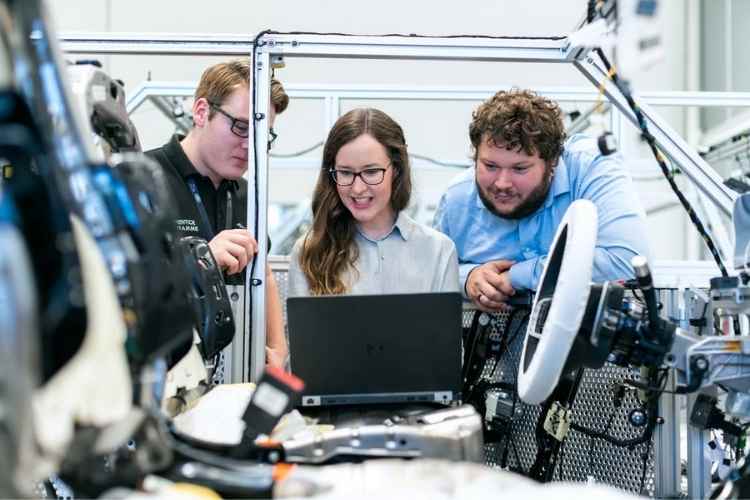The world is going forward with a renewed focus on safety, and that’s nowhere more apparent than in the auto industry. The automotive safety market is expected to grow to over $198 billion in value by 2028, according to Verified Market Research. Among other technology sectors, car tech is accelerating at an unprecedented rate. The latest auto tech developments are all being driven by advancements in car electronics and automation, and vehicle safety tech is no different.
Advanced Sensing Equipment
As onboard sensors improve, automobile manufacturers are starting to develop equipment that can detect an even larger array of objects and obstacles. One of the leading technologies is pedestrian detection, which uses radar and cameras in conjunction to alert drivers of pedestrians, which is invaluable in low-light areas. At the moment, however, it is far from perfect, so drivers of cars equipped with this system are advised to remain vigilant.
Other novel sensors include safe exit warnings, which make use of rear-mounted sensors to warn the driver of approaching vehicles when backing out of a narrow path, such as an alley or a parking space. Similar radar-based systems detect oncoming vehicles at an intersection, helping to prevent crashes due to inattentiveness. Some systems make use of millimeter wave or mmWave technology. This has proven to be most useful when mounted on car doors, as it can prevent damage to it and anything it might hit while being opened. Appended with the same tech behind blind spot monitors, the latest car door sensors can warn against being opened if there are vehicles coming up from behind.
Optical Safety Enhancements
Cameras are becoming cheaper and easier to fit onto vehicles, and hence auto manufacturers are making full use of them to advance car safety. You may have heard of blind spot cameras and reverse cameras, which sheds light on areas of notoriously poor visibility across all vehicles. Car cameras are now expanding past this, in order to provide the driver as much visual information as possible without requiring them to turn their heads away from the road. A relatively new type of camera that’s recently gaining traction is the cabin camera. This provides the driver and front passenger seat with a live feed of what’s going on throughout the cabin, removing the need to turn one’s head to look.
All of these camera-based safety technologies are serving as a testing ground for the optics component of vehicle-to-vehicle connectivity. Among other things, this vehicular branch of the Internet of Things is set to enhance vehicle safety to a never-before-seen degree, thanks to inter-car communication. Much of vehicle IoT at this point relies on sensors, which can be quite inaccurate when conditions are less than ideal. If supported by a visual feed and enhanced AI, it could substantially benefit the accuracy. For now, having a lot of cameras is still a big help for collecting data on the road. This is invaluable if you become embroiled in a car accident case, as the data will enable a car accident lawyer to fight more effectively on your behalf.
Assist Systems Driven By Automation
Debates are still ongoing as to whether replacing most cars with automotive vehicles will be entirely feasible within the next decade or so. In the meantime, much of the tech that goes into vehicle automation can do much to improve the safety in traditional manned vehicles. One such technology is parking assist. A long-awaited feature, parking assist lets you park a car with the single push of a button. Collision detectors and other spatial-aware sensors ensure that there is little to no chance of error with the function, helping drivers skip the inconvenience of parking in a tight spot.
Automated assists are also helping improvements in collision prevention. To complement things like advanced warning and automatic brakes, we have the modern-day iteration of anti-locking brakes. ABS’s primary function was to automatically release hydraulic fluid if the wheels were spinning too slow, to prevent unresponsive braking and locking up of the wheels. However, it did this through analog means, which can become faulty at the worst opportunities. Using automation and modern sensing tech, however, cars can now perfectly tailor the delivery of hydraulic fluid to the situation, ensuring smooth handling at all times. Another good example of electronic safety measures is Electronic Stability Control. In the event of a tire pressure drop, loss of traction, or a general loss of control, an ESC can apply brakes to individual tires and cut the engine if necessary.
Life-Saving Countermeasures
When all else fails, a car’s built-in lifesaving features are going to be the ultimate deciding factor for the safety of its occupants. For the longest time, this came down to seatbelts, airbags, and crumple zones. These basic mechanical technologies are based on a simple principle, to mitigate damage to the people inside the car as much as possible. Hence, it’s relatively straightforward to protect occupants against sources of injury. Airbags prevent blunt force, seatbelts prevent whiplash, and crumple zones prevent trauma from the cabin collapsing in on the people inside.
But the methods manufacturers have been using to meet these ends do have flaws. A multitude of variations have been thought up to shore up these flaws, such as surround airbags. However, these innovations were still slightly faulty in their approach. Recently, however, thanks to strides in material science, we’re now starting to develop even more refined solutions to the failings of basic lifesaving devices. A chief example would be center-mounted airbags, which more readily protect an occupant’s head and spine than a surround airbag would, because it needs less time to deploy in order to cushion the important areas. Coupled with improved headrests, this can vastly reduce the amount of head trauma a car crash victim experiences. In terms of structural improvements, crumple zones are now being constructed with novel composites that collapse more effectively, allowing engineers to have better control over the transfer of impact force.
The fact that such great strides are being made in these areas means that auto R&D teams have finally honed in on the primary sources of serious car-related injury. If all goes well, we may expect a downturn in the number of such injuries from here on out.

